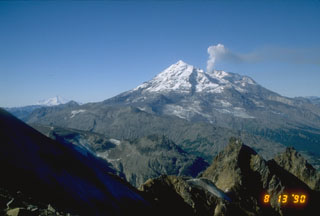Report on Redoubt (United States) — 23 December-29 December 2009
Smithsonian Institution / US Geological Survey
Weekly Volcanic Activity Report, 23 December-29 December 2009
Managing Editor: Sally Sennert.
Please cite this report as:
Global Volcanism Program, 2009. Report on Redoubt (United States) (Sennert, S, ed.). Weekly Volcanic Activity Report, 23 December-29 December 2009. Smithsonian Institution and US Geological Survey.
Redoubt
United States
60.485°N, 152.742°W; summit elev. 3108 m
All times are local (unless otherwise noted)
AVO reported that during 27-28 December seismic activity from Redoubt changed from the pattern noted during the previous five months, and was characterized by a series of small repetitive earthquakes that occurred in the vicinity of the summit. The Volcanic Alert Level was raised to Advisory and the Aviation Color Code was raised to Yellow. Based on pilot reports and web camera views, no unusual activity or plumes were noted.
Geological Summary. Redoubt is a glacier-covered stratovolcano with a breached summit crater in Lake Clark National Park about 170 km SW of Anchorage. Next to Mount Spurr, Redoubt has been the most active Holocene volcano in the upper Cook Inlet. The volcano was constructed beginning about 890,000 years ago over Mesozoic granitic rocks of the Alaska-Aleutian Range batholith. Collapse of the summit 13,000-10,500 years ago produced a major debris avalanche that reached Cook Inlet. Holocene activity has included the emplacement of a large debris avalanche and clay-rich lahars that dammed Lake Crescent on the south side and reached Cook Inlet about 3,500 years ago. Eruptions during the past few centuries have affected only the Drift River drainage on the north. Historical eruptions have originated from a vent at the north end of the 1.8-km-wide breached summit crater. The 1989-90 eruption had severe economic impact on the Cook Inlet region and affected air traffic far beyond the volcano.
Source: US Geological Survey Alaska Volcano Observatory (AVO)

